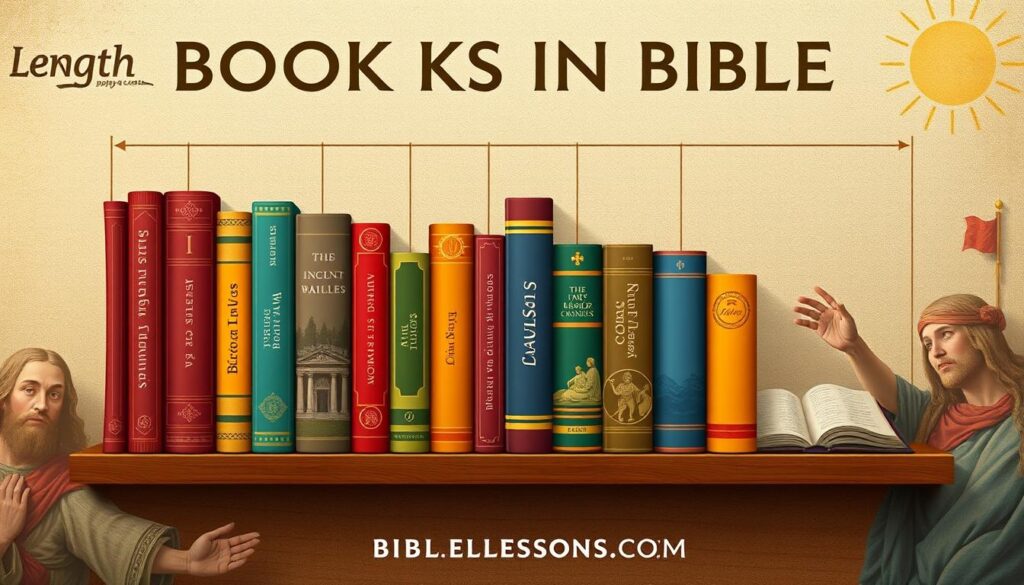Ever wondered how many pages the Bible has? It’s not a simple question. The Bible is a mix of many texts from different times. The number of pages changes based on the version, translation, and how it’s formatted.
Let’s dive into the interesting facts behind this question.
Key Takeaways
- The average Bible contains approximately 1,200 pages.
- The Bible is not a single book but a collection of 66 books, including 39 in the Old Testament and 27 in the New Testament.
- Factors such as font size, page layout, and inclusion of supplementary materials can influence the total page count.
- Different Bible translations and versions can result in varying page numbers, with some editions containing over 2,000 pages.
- The page count can also be affected by the language of the translation, with some versions being more concise or expansive than others.
While knowing the exact page count of the Bible might not be crucial, it’s interesting to understand the range and factors involved. By exploring the Bible’s composition and publication, we can appreciate its complexity and diversity. This helps us value this timeless collection of sacred writings more deeply.
Understanding the Term “Bible”
The Bible is a collection of sacred texts for many religions. It includes stories, poems, and prophecies. The word “Bible” comes from the Greek “biblia,” meaning “the books.”
What is the Bible?
The Bible is a key text for Abrahamic faiths. It has 66 books, split into the Old and New Testaments. It has stories, conflicts, and resolutions, shaping culture and history.
Etymology and Development of the Word “Bible”
The term “Bible” evolved into a single word in medieval Latin. It then spread to Western Europe’s languages. The Bible has sold over five billion copies, making it the top-selling book ever. It’s translated into about half of the world’s languages today.

“The Bible is the word of God and when I see it I feel that I am holding the destiny of man in my hands.”
– Mahatma Gandhi
| Metric | Value |
|---|---|
| Average Word Count | 783,137 |
| Average Reading Time | 55 hours |
| Number of Books | 66 |
| Old Testament Language | Hebrew (with Aramaic) |
| New Testament Language | Greek |
Composition of the Bible
The Bible is sacred to both Christianity and Judaism. It has two main parts: the Old Testament and the New Testament. Each part has many books, showing the history, teachings, and spiritual insights of these faiths.
The Old Testament Books
The Old Testament has 39 books. It starts with the Torah, the first five books, and ends with prophetic writings and poems. It tells of the world’s creation, the Israelites’ beginnings, their journey, and the kingdom of Israel. It also includes warnings and guidance from prophets.
The New Testament Books
The New Testament has 27 books. It focuses on Jesus Christ’s life, teachings, death, and resurrection. It also covers the early Christian church. The section includes the four Gospels, Acts of the Apostles, Epistles, and Revelation.
| Scripture Section | Number of Books |
|---|---|
| Old Testament | 39 |
| New Testament | 27 |
| Total Books in the Bible | 66 |
The Bible’s structure, with Old and New Testaments, shows the history and theology of Judeo-Christian traditions. It gives a deep understanding of the Bible’s religious, cultural, and literary value.

Early Manuscripts and Translations
The Bible we know today has a long history. It was written and copied by hand on materials like papyrus scrolls. Sadly, no original manuscripts have survived to this day. Scholars still debate when the original texts were written.
The Dead Sea Scrolls are a major discovery. Found in the 1940s, they are the oldest copies of the Hebrew Bible. They date from 250 BCE to 100 CE. These scrolls give us a peek into how the Bible evolved and the traditions of ancient times.
As the Bible spread, it was translated into languages like Greek, Latin, Syriac, and Aramaic. Early translations, like the Septuagint and the Vulgate, helped spread and interpret the Bible.
| Manuscript/Scroll | Description | Significance |
|---|---|---|
| Dead Sea Scrolls | Discovered in the 1940s, the Dead Sea Scrolls are the oldest existing copies of the books of the Hebrew Bible, dating back to between 250 BCE and 100 CE. | Provide invaluable insights into the evolution of the biblical canon and the textual traditions of the ancient world. |
| Codex Leningradensis | Dated to 1008 CE, Codex Leningradensis is the oldest complete Hebrew manuscript of the entire Old Testament. | Serves as a reliable source for the text of the Hebrew Bible. |
| Codex Vaticanus | Dated to the 4th century, Codex Vaticanus is one of the earliest complete manuscripts of the Bible. | Considered a valuable witness to the biblical text, it is one of the most important ancient manuscripts. |
| Codex Sinaiticus | Dated to the 4th century, Codex Sinaiticus is the earliest complete Greek New Testament manuscript. | Regarded as one of the most significant ancient biblical manuscripts, it provides important insights into the early textual history of the New Testament. |
Studying early Bible manuscripts and translations is key to understanding the Bible’s history. These ancient texts help us grasp the Bible’s role in ancient cultures and religions.

Biblical Canons and Compilations
The Bible is a collection of books that have been recognized as sacred by many. The first part, the Torah, was accepted by Jews in the 5th century BCE. It includes the first five books of the Hebrew Bible.
The Hebrew Bible (Tanakh)
Later, the Nevi’im (prophets) and Ketuvim (writings) were added. Together, they form the complete Hebrew Bible, or Tanakh. It has 24 books, divided into three sections.
The Christian Old and New Testaments
Christians use the Septuagint, a Greek version of the Tanakh, as their Old Testament. The New Testament, with 27 books, was added later. This makes the Christian Bible have 66 books.
| Biblical Canon | Number of Books | Composition |
|---|---|---|
| Hebrew Bible (Tanakh) | 24 | Torah (5), Nevi’im (8), Ketuvim (11) |
| Catholic Old Testament | 46 | Includes deuterocanonical books |
| Protestant Old Testament | 39 | Excludes deuterocanonical books |
| Christian New Testament | 27 | Gospels, Acts, Epistles, Revelation |
Over time, different groups have recognized different books as sacred. This shows the Bible’s rich history and its impact on cultures worldwide.

The Longest Books of the Bible
The Old Testament books are the longest in the Bible by word count. The top five are:
- Jeremiah with 33,002 words
- Genesis with 32,046 words
- Psalms with 30,147 words
- Ezekiel with 29,918 words
- Exodus with 25,957 words
The top ten longest books are all from the Old Testament. This includes Isaiah, Numbers, Deuteronomy, 2 Chronicles, and 1 Samuel. These numbers are based on the original Hebrew and Aramaic texts, not English translations.
| Book | Word Count |
|---|---|
| Jeremiah | 33,002 |
| Genesis | 32,046 |
| Psalms | 30,147 |
| Ezekiel | 29,918 |
| Exodus | 25,957 |
Originally, the Bible was divided into volumes because of scroll limits. For example, First and Second Samuel were once one book called Samuel.

How Many Pages are in the Bible?
The number of pages in the Bible changes a lot. It depends on the version, translation, and how it’s formatted. Things like font size, page layout, and extra materials also play a part. The language used can affect the page count too.
A standard Bible usually has about 1,200 pages. But, it can have anywhere from 1,000 to over 2,000 pages. The Old Testament has 929 chapters, 23,214 verses, and about 622,700 words. The New Testament has 260 chapters, 7,959 verses, and roughly 184,600 words.
Different Bible versions and translations can change the page count. For example, the King James Version, Revised Standard Version, and New American Standard Version vary. Including extra books like the Apocrypha can also make the Bible longer.
Other factors affecting Bible page count include font size, spacing, and page size. The rise of digital Bibles has also changed how we read the Bible. Now, we can access it without physical pages.
In summary, the average Bible page count is about 1,200 pages. But, the Bible page range can change a lot. This depends on the Bible size variations and other factors. Knowing these details is key when talking about the Bible’s physical size and makeup.
Historical Impact and Influence
The Bible is the best-selling book of all time. It has greatly influenced world history. This sacred text has shaped Western civilization and global cultures.
The Bible’s history is rich. It started in ancient Israel and Judea. Today, it’s translated into over 3,000 languages. It has influenced literature, art, music, law, and social norms.
The Old Testament tells of the Earth’s creation and key events like the Exodus. The New Testament shares the life of Jesus and the rise of Christianity. Both have deeply impacted human history.
The Bible’s global influence is vast. Over 5 billion copies have been sold. It has united people across cultures and languages. The Septuagint and the King James Bible are examples of its wide reach.
Studying the Bible has influenced many fields. This includes archaeology, linguistics, sociology, and psychology. Its ongoing study continues to reveal new insights and challenge our views of the world.
“The Bible has been the most widely distributed, influential, and significant book in human history. Its impact on Western civilization is incalculable.”
In conclusion, the Bible’s impact is clear. It has shaped Western and global civilization. This sacred text continues to inspire and shape our understanding of the world.
Writing and Transmission Methods
The biblical texts started as oral traditions. Songs and stories were passed down through generations. Later, these traditions were written down in written texts. The first books were written in paleo-Hebrew scripts.
As time went on, the script changed. Spaces were added between words to make reading easier. This helped in the Bible manuscript development.
The Dead Sea Scrolls were written in square script. This script was used until the 8th century CE, when vowel signs were added. The Bible writing process involved careful copying and transmission. This ensured the texts were kept safe for centuries.
From Oral Traditions to Written Texts
The Bible oral traditions and Bible transmission history were key in creating the biblical texts. Scribes in the ancient Near East wrote and kept these important documents. Different versions emerged due to various editing and compilation processes.
- The earliest texts were on scrolls made from papyrus or parchment. Later, they were written in codex form in the second or third century C.E.
- Canonization, or selecting authoritative books, varied among religious communities. This led to different canons among Jewish, Christian, Catholic, Eastern Orthodox, and Protestant traditions.
- The books of the Torah were seen as sacred from at least the second century B.C.E. Other potential biblical books were not widely accepted in canonical lists during the first century C.E.
The Bible writing process and Bible manuscript development were crucial. They helped preserve the sacred texts. This ensured their lasting impact and influence throughout history.
“The Bible, as known today, consists of a collection of books, each with unique histories, written and edited by various authors over a thousand-year period.”
Biblical Languages and Scripts
The biblical texts were written in three ancient languages: Hebrew, Aramaic, and Koine Greek. Most of the Old Testament was in Biblical Hebrew, with some parts in Aramaic. The New Testament was in Koine Greek, the common language of the Eastern Mediterranean.
The shift from paleo-Hebrew to the square script shows the evolution of biblical languages and scripts. This change shaped the Hebrew Bible and influenced how the language of the Bible was kept and shared over time.
Hebrew, Aramaic, and Greek
The Hebrew Bible was mainly written in Biblical Hebrew, a Semitic language. Some parts, like Ezra, Daniel, and Jeremiah, were in Aramaic, another Semitic language used in the ancient Near East.
The New Testament was written in Koine Greek, the common language of the Mediterranean. This Greek was simpler and more spoken than the formal Attic Greek.
| Language | Usage in the Bible | Script |
|---|---|---|
| Biblical Hebrew | Majority of the Old Testament | Paleo-Hebrew, Square script |
| Aramaic | Portions of the Old Testament | Aramaic script |
| Koine Greek | The New Testament | Greek alphabet |
“The language of the Bible is not just a linguistic phenomenon, but a reflection of the rich cultural and historical context in which the biblical texts were composed and transmitted.”
Biblical Criticism and Interpretation
The Bible has been studied deeply by scholars for a long time. They use methods like historical and textual criticism to understand the texts. These studies help us know more about who wrote the Bible and when.
Textual criticism is key in this field. It looks at old manuscripts to find the original text. With so many copies, scholars work hard to figure out what the authors meant.
Biblical hermeneutics is also important. It’s about how to understand the Bible. Scholars use different ways to grasp its meaning, helping us see its value today.
“The book ‘Biblical Criticism and Interpretation’ provides a comprehensive one-stop Handbook reference of biblical interpretation, covering a wide range of perspectives and interpreters.”
Biblical exegesis is another vital area. Experts like Amy Anderson and Wendy Widder have made big contributions. They study ancient languages and how we understand texts today.
In short, studying the Bible through different methods is crucial. It helps us understand its importance in our world. Scholars’ work gives us a deeper look into the Bible’s meaning and impact.
| Book Title | Pages | Description |
|---|---|---|
| “Biblical Criticism and Interpretation” | 424 | Provides a comprehensive one-stop Handbook reference of biblical interpretation, covering various interpreters and perspectives. |
Bible Translations and Versions
The Bible has been translated into many languages over time. The Septuagint and the Vulgate were early translations. They helped spread and keep the Bible safe, and they shaped how we understand it today.
Early Translations like the Septuagint
Many more translations have been made since then. These include the King James Version (KJV), New Revised Standard Version (NRSV), and others. Each one aims to make the Bible clear to different people around the world.
These translations show how different words and meanings can be. They show the challenges of translating sacred texts. Looking at these translations helps us see how different views of the Bible can emerge.
| Bible Translation | Distinguishing Features |
|---|---|
| King James Version (KJV) | Considered a more literal translation, based on the Masoretic Text and Textus Receptus |
| New Revised Standard Version (NRSV) | A widely-used modern English translation, based on the Masoretic Text and Septuagint |
| Jewish Publication Society (JPS) | A translation of the Hebrew Bible by Jewish scholars, focused on accuracy and readability |
| Darby Bible (DBY) | A literal translation by John Nelson Darby, emphasizing a word-for-word approach |
| Tyndale Bible (TNT) | One of the earliest complete translations of the Bible into English, published in the 16th century |
The history of English Bible translations is long. The first complete English Bible was made by John Wycliffe in 1382. Since then, many more have been made, each with its own view of the Bible.
Cultural and Literary Significance
The Bible has deeply influenced Western culture and literature. Its stories and teachings have shaped many artistic works, music, literature, and philosophy. This shows its lasting importance and role in human culture and thought.
The Bible’s cultural impact is clear. It’s one of the top-selling books globally, with billions sold each year. Its stories, like the creation tale in Genesis and the Exodus, are part of Western culture. Many famous artworks, like Michelangelo’s Sistine Chapel and Rembrandt’s The Storm on the Sea of Galilee, take inspiration from the Bible.
The Bible’s literary influence is also vast. It has various genres, such as law, history, and prophecy, which have shaped literature for centuries. The Gospels, for example, use symbols and literary devices. The book of Proverbs is complex, needing deep interpretation to understand its meaning.
The Bible’s role in art and literature goes beyond the text itself. Works like John Milton’s Paradise Lost and T.S. Eliot’s The Waste Land draw from biblical themes and imagery. The Bible’s significance in Western civilization is clear, as it remains a source of inspiration for artists, writers, and thinkers.
“The Bible is the greatest work of literature ever written, and the greatest treasure of the human spirit.” – Archibald MacLeish
In summary, the Bible’s cultural and literary impact is remarkable. Its influence on art, music, literature, and philosophy highlights its importance as a foundational text. It continues to shape Western culture and thought.
Conclusion
The number of pages in the Bible can change a lot. It can be from about 1,000 to over 4,000 pages. This depends on the version, translation, and how it’s printed.
The Bible has different parts like the Old and New Testaments. The way these books are chosen and put together also affects the page count. This is true for different editions and groups.
Understanding the Bible’s makeup and history is key. Things like translation, edition, and print size matter. So do study notes and books not in the main canon.
The Bible’s lasting impact on art, literature, history, and culture is huge. It shows why we need to study it carefully. This helps us understand its deep meaning and influence.
So, the Bible’s page count doesn’t fully show its importance. It reflects the Bible’s depth and wide-ranging effects on the world.
FAQ
How many pages are in the Bible?
The Bible’s page count varies by version and format. Most Bibles have about 1,200 pages. However, it can range from 1,000 to over 2,000 pages.
What is the Bible?
The Bible is a collection of sacred texts for many religions. It includes stories, poems, and teachings. The word “Bible” comes from the Greek “biblia,” meaning “the books.”
How is the Bible composed?
The Bible has two main parts: the Old and New Testaments. The Old Testament has 39 books, covering history and prophecy. The New Testament has 27 books, focusing on Jesus and the early church.
What are the earliest known biblical manuscripts?
The earliest texts were handwritten on papyrus scrolls. No original manuscripts remain. The Dead Sea Scrolls, from 250 BCE to 100 CE, are the oldest copies.
What are the biblical canons and compilations?
Different communities compiled the Bible into canons. The Torah was accepted by 5th century BCE Jews. The Hebrew Bible, or Tanakh, includes the Torah, Nevi’im, and Ketuvim. Christians use the Septuagint and add the New Testament.
What are the longest books of the Bible by word count?
The longest books are mostly in the Old Testament. The top ten include Jeremiah, Genesis, and Psalms. These books have thousands of words.
In what languages were the biblical texts written?
The texts were written in Hebrew, Aramaic, and Koine Greek. Most of the Old Testament is in Hebrew, with some Aramaic. The New Testament is in Koine Greek.
How has the Bible been interpreted and studied?
Scholars have studied the Bible through biblical criticism. They use various methods to understand its origins and meaning. This has led to ongoing debates and discussions.
What is the cultural and literary significance of the Bible?
The Bible has greatly influenced Western culture and literature. Its stories and teachings have shaped art, music, and philosophy. Its impact is seen in many forms, showing its lasting significance.

